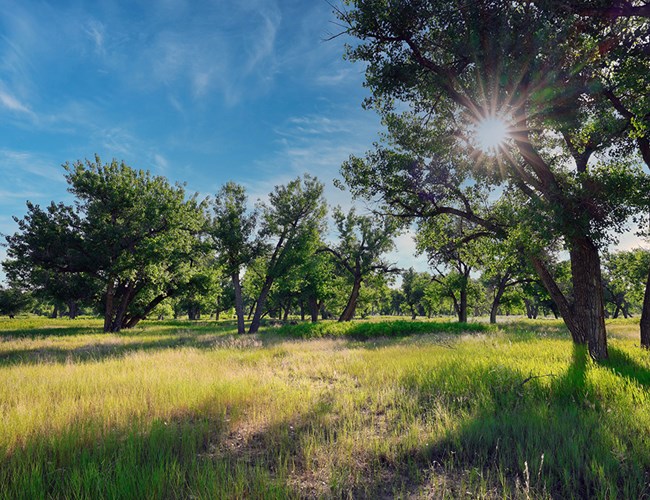Last updated: September 19, 2024
Article
Climate and Weather Monitoring at Bent's Old Fort National Historic Site: Water Year 2021

NPS/STUART WEST
Overview
Together, climate and hydrology shape ecosystem structure and function, particularly in arid and semi-arid ecosystems. Understanding changes in climate, groundwater, and surface water is key to assessing the condition of park natural resources—and often, cultural resources.
At Bent's Old Fort National Historic Site, our Southern Plains Inventory and Monitoring Network scientists study how ecosystems may be changing by taking measurements of key resources or “vital signs” year after year, much as a doctor keeps track of a patient's vital signs. This long-term ecological monitoring provides early warning of potential problems, allowing managers to mitigate them before they become worse. We monitor climate and weather among other vital signs at the park.
Climate and weather reporting is by water year (WY), which begins in October of the previous calendar year and goes through September of the water year (e.g., WY2021 runs October 2020 through September 2021). Information is added to this page as it becomes available throughout the year.

NPS/STUART WEST
Climate and Weather
There is often confusion over the terms, “weather” and “climate.” In short, weather describes instantaneous meteorological conditions (e.g., it's currently raining or snowing, it's a hot or frigid day). Climate reflects patterns of weather at a given place over longer periods of time (seasons to years). Climate is the primary driver of ecological processes on Earth. Climate and weather information provide context for understanding the status or condition of other park resources.
Methods
A National Oceanic and Atmospheric Administration Cooperative Observer Program weather station (La Junta Municipal Airport, Colorado #054720; Figure 1) is located 4.2 miles (6.7 kilometers) west of Bent's Old Fort National Historic Site and has been in operation since 1945. This station provides a reliable, long-term climate dataset used for all analyses in this climate and weather report. Data from this station are accessible through Climate Analyzer.

NPS
Recent Findings
Precipitation
Annual precipitation at the station near Bent’s Old Fort National Historic Site in WY2021 was 10.43" (26.5 cm; Figure 2), 0.91" (2.3 cm) less than the 1991–2020 normal. More than half of the year’s precipitation fell in May, 5.37" (13.6 cm). This was over three times the normal (1991–2020) May rainfall. September was also wetter than normal, receiving twice the 1991–2020 normal precipitation. Rainfall during all other months was near or below the 1991–2020 normals. Extreme daily rainfall events (≥ 1"; 2.54 cm) occurred on 1 day—29 May 2021 (1.35"; 3.4 cm). This was less than the normal annual frequency of 1.8 days.
Air Temperature
Mean annual maximum air temperatures in WY2021 were 1.0°F (0.6°C) warmer than the normal 70.0°F (21.1°C), and mean annual minimum air temperatures were 0.5°F (0.3°C) warmer than the normal minimum of 39.6°F (4.2°C; normal is based on means from 1991–2020). Mean monthly maximum and minimum temperatures were exceptionally variable relative to normal (Figure 2). February was much colder than normal; the mean maximum temperature was 10.4°F (5.7°C) below the 1991–2020 normal. Substantially warmer mean monthly maximum temperatures occurred in November and September, 7.7°F (4.0°C) and 5.5°F (3.1°C) above normal, respectively. Extremely hot temperatures (> 99.0°F; 37.2°C) were recorded on 33 days in WY2021, almost twice the normal frequency (18.0 days). Extremely cold temperatures (< 11°F; −11.7°C) occurred on 17 days, which was similar to the normal frequency of 17.7 days.

Climateanalyzer.org
Drought
Reconnaissance drought index (Tsakiris and Vangelis 2005) provides a measure of drought severity and extent relative to the long-term climate. It is based on the ratio of average precipitation to average potential evapotranspiration (water loss due to evaporation and plant transpiration if water supply is not limited) over short periods of time (seasons to years). The reconnaissance drought index for Bent’s Old Fort National Historic Site indicates WY2021 was a slightly drier year than the 1991–2021 average from the perspective of both precipitation and evapotranspiration (Figure 3).
Reference: Tsakiris G., and H. Vangelis. 2005. Establishing a drought index incorporating evapotranspiration. European Water 9: 3–11.

Climateanalyzer.org
Please cite this report as
Raymond, K., and A. Ray. 2023. Climate and Weather Monitoring at Bent's Old Fort National Historic Site: Water Year 2021. Southern Plains Network, National Park Service, Pecos, New Mexico.
